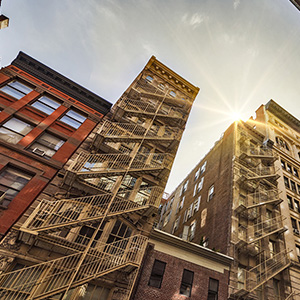Local Law 97: 2023 Updates from the New York City Department of Buildings
FirstService Energy has helped boards and owners save millions on utility costs, efficiency upgrades, and compliance violations. Let’s find out how we can make a difference at your building.
A special legislative update from Kelly Dougherty, President of FirstService Energy.
 The Climate Mobilization Act (CMA) sets annual emissions standards (carbon limits) for all buildings 25,000 gross square feet and above beginning in 2025. Each building’s carbon budget/cap is based on their defined occupancy type (multifamily, retail, etc.), the corresponding square footage of each space and the limits for each occupancy type as defined in the law.
The Climate Mobilization Act (CMA) sets annual emissions standards (carbon limits) for all buildings 25,000 gross square feet and above beginning in 2025. Each building’s carbon budget/cap is based on their defined occupancy type (multifamily, retail, etc.), the corresponding square footage of each space and the limits for each occupancy type as defined in the law.Beginning May 1, 2025, every building will need to submit whole-building annual data from the previous calendar year. If the building goes over its emissions budget/cap, a fine will be assessed on the property. Over the past several years, FirstService Energy has provided our boards and owners with information regarding the CMA. In addition to educational webinars, FAQs, and other resources, we have provided estimated fines on an annual basis in our Energy Report Cards to help prepare our clients for compliance.
In 2022, the Department of Buildings (DOB) released Local Law 97 (LL97) updated rules. The two most relevant items from those rules that affect our managed properties are 1) updated co-efficient for electricity for the 2030 – 2034 compliance period, and 2) the change in occupancy definition to align with EPA Portfolio Manager.
To read the entire 2022 rules, click here.
Last week, the DOB released its next set of draft rules which provide clarity on several topics. The draft rules are subject to potential amendments before being finalized.
The draft rules include the following topics:- Define “Good Faith Effort” for the 2024 – 2029 compliance period,
- Establish a beneficial electrification credit,
- Establish a penalty for failure to comply with emissions reporting,
- Establish a penalty for exceeding the building’s emission limits,
- Establish an enforcement framework for penalties if building owners don’t comply with the law,
- Provide a framework for mediated resolutions, and
- Prohibit buildings that submit a decarbonization plan from purchasing renewable energy credits.
We want to emphasize that these rules in no way provide a free pass for complying with the emissions limits set forth in the original law.
Recent media articles have suggested the “Good Faith Effort” comes as a great relief to buildings in avoiding penalties. However, achieving this designation is a complex path. For buildings projected to go above their emissions budget in the first compliance period (2024 – 2029), and have taken proactive steps to meet compliance, these rules do give some additional time to complete the necessary retrofits.With that said, we highly recommend that all buildings prepare for LL97 by conducting a decarbonization roadmap with an established, reputable engineering firm. This plan should lay out options for meeting emissions limits and a potential timeline following the language in the draft rules. As we know, construction and financing can take years of planning. Therefore, even if your building is not projected to have a fine until 2030 or beyond, we still highly recommend that you take proactive measures to plan. Your management team will administer this process for you.
If you are unsure of your estimated fines, please contact your property manager for assistance. An FAQ is below for your convenience. If you have additional questions not addressed in the communication, please submit them here and FirstService Energy will respond as soon as possible.
Frequently asked questions: How the 2023 LL97 draft rules effect boards and building owners
My building is projected to have a fine in 2025. What actions does my building need to take to achieve “Good Faith Effort”?
As per the DOB 2023 draft rules, “Owners who have not yet accomplished the level of work necessary to comply with the emissions limit, may submit a decarbonization plan no later than May 1, 2025, setting forth a path for compliance, provided they meet the additional eligibility criteria set forth in the rule.”The criteria include:
- Submitting the annual building emissions report and maintaining compliance with any adjustment DOB has granted,
- Complying with LL84 (energy benchmarking)
- Complying with LL88 of 2009, as amended – Lighting Upgrades and Sub-meter Installation–Lighting Upgrades and Sub-meter Installation
- Demonstrating that work necessary to achieve compliance is currently underway by having a fully-approved application and a permit issued for such work
- Demonstrating that electrification readiness work is underway by securing an approved alteration application and a letter from a utility attesting to the work
- Demonstrating that the building was previously under the emissions limit for the previous reporting year
- Demonstrating that the building is a critical facility, such as a hospital, whose services would be significantly impacted if they have to pay the full penalty
- Demonstrating that the building has applied for, or been granted, an adjustment pursuant to section 28-320.7 of the Administrative Code
- Providing a decarbonization plan by May 1, 2025 that will bring the building into compliance with its 2024 limits no later than 2026, and with its 2030 limits no later than 2030, and demonstrating each year through 2030 that the work is proceeding on schedule
What does a decarbonization plan require and when will we need to begin construction?
[A] No later than May 1, 2025, an owner must submit a decarbonization plan that is being implemented to the DOB.Such plan must include:
- An energy audit prepared by a qualified energy auditor
- An inventory of all HVAC equipment, domestic hot water equipment, electrical equipment, lighting, and conveyance equipment serving the building, including the date of installation of such equipment and, where applicable, whether such equipment serves multiple buildings
- A description of any work that received a certificate of completion or temporary certification of occupancy on January 1, 2013 or later, that resulted in no less than a 10% emissions reduction for the building as compared to the emissions measured the year prior to the completion of such work
- A list of alterations and changes to operations and maintenance that will result in the building achieving emissions reductions required by Article 320 of Chapter 3 of Title 28 of the Administrative Code and rules promulgated thereunder and resulting in net zero carbon emissions in 2050, including energy conservation measures to be undertaken during the current and future compliance periods, and the complete schedule for retrofit strategies necessary to reach net zero carbon emissions. Compliance strategies may not include the removal of a tenant
- A timeline for each alteration or change to operations that demonstrates when the work will be completed in order to meet required emissions reductions during each compliance period; and
- A capital plan for such work, including financing and incentives; and
- The corresponding emissions reductions estimated to result from each alteration or change to operations; and
- Within 24 months of the plan submission, demonstrate that the work necessary to bring the building into emissions compliance for calendar year 2024 is completed
- By May 1, 2028, provide evidence that a complete application has been approved by the DOB or the work necessary to comply with such building’s 2030 emissions limit
[C] An owner must provide evidence that the covered building is undergoing work to achieve electric readiness.
Suitable evidence includes:
- An approved electrical alteration application to make upgrades to the building’s electric service for the purposes of future replacement of fossil fuel-based equipment with electric equipment; and
- Certification that the electric utility has received the contractor work request and/or has approved a load letter for service increase; and
- An anticipated timeline for completion of the work; or
[D] An owner must submit an annual building emissions report during the 2024-2029 compliance period that demonstrated such building was under the established limits for the calendar year that such report was submitted; or
[E] An owner of a critical facility provides a description with documentation, in a form and manner determined by the DOB, of how payment of a penalty would impact the operations of such facility; or
[F] An owner attests in a form and manner determined by the DOB that such owner has applied for or been granted an adjustment in accordance with section 28-320.7 of the Administrative Code and rules promulgated thereunder.
What is “Beneficial Electrification” and how can it assist my building in meeting the emissions limits?
Buildings that choose to undertake electrification efforts early on will be eligible (depending on the measure taken) for a “beneficial electrification” credit. Beneficial electrification is defined as “efficient electric-based heating, cooling, and domestic hot water to displace the use of fossil fuel sources and/or less efficient electric-based heating systems.” The equipment selected must meet minimum efficiency ratings as defined in the draft rules. Your building may utilize the “beneficial electrification” electric coefficient (see below) when calculating GHG resulting from the electric equipment in use.- Equipment installed and operating between January 1, 2027, and December 31, 2029, shall be -0.00065 tCO2e/kWh..
- Equipment installed and operating between January 1, 2021, and December 31, 2026, shall be -0.0013 tCO2e/kWh.
- Must be separately metered by the utility; or
- Must be separately metered or sub-metered by the owner in a manner that produces auditable data aligned with the reporting year; or
- Must be capable of and configured to produce data that records the electricity supplied to the equipment over the course of the reporting year by means of hardware and software integrated with the equipment.
Are extensions available for income-restricted housing?
Extensions are available for certain income-restricted housing and other covered buildings. The reporting requirement described in the law has been modified for certain covered buildings in the draft rules as follows:- For a covered building that has at least 1 but fewer than 35% of dwelling units required by law or by an agreement with a governmental entity to be regulated in accordance with the emergency tenant protection act of 1974, the rent stabilization law of 1969, or the local emergency housing rent control act of 1962, as set forth in section 28-320.3.10.1 of the Administrative Code, the initial report must be submitted by May 1, 2027;
- For a covered building that is owned by a limited-profit housing company organized under article 2 of the Private Housing Finance Law, as set forth in section 28-320.3.9 of the Administrative Code, the initial report must be submitted by May 1, 2035;
- For a covered building that has at least 1 dwelling unit for which occupancy or initial occupancy is restricted based upon the income of the occupant or prospective occupant thereof as a condition of a loan, grant, tax exemption, tax abatement, or conveyance of property from any state or local governmental agency or instrumentality pursuant to the private housing finance law, the general municipal law, or section 420-c of the real property tax law, as set forth in section 28-320.3.9 of the Administrative Code, the initial report must be submitted by May 1, 2035.
My building has a cogeneration system (also known as Cogen or CHP) installed. What are the requirements for reporting emissions with this unit?
GHG coefficient for distributed energy resources. All distributed energy resources must be separately metered or sub-metered in a manner that produces data for the year being reported.Where an owner chooses to utilize a utility electricity GHG coefficient based on time of use (TOU) to account for operation of distributed energy resources, such owner must use a TOU coefficient for all utility electricity consumption for their reporting. GHG calculations must follow the equation outlined in the draft rules.
Have there been updates to the penalty for not filing building emissions reports annually?
Yes. The owner of the covered building shall be liable for a civil penalty for failing to file an emissions report within 60 days of the reporting deadline, or by the extension deadline granted by the DOB. The penalty will be an amount equal to gross floor area, multiplied by $0.50 for each MONTH the report is not submitted, including the 60 days following the deadline.Example: 50,000 Sq. Ft. Building = $25,000/month
Is there an option for an extension to file annual emissions?
Yes. If an owner has made a good faith effort, they may apply for an extension 30 days in advance and no later than 60 days after May 1st annually. The owner of the building must report to the DOB that the good faith efforts below have been taken, and must include the following:- A registered design professional has been hired but could not complete the report by the deadline.
- The executed contract with the design professional should be executed by February 1st of each year.
- A signed affidavit by the owner and design professional stating that they were unable to complete the report and that it will be filed within 120 days.
What will happen if my building is unable to meet the 2024 – 2029 limits?
The building will have to pay a fine based on the difference between the actual emissions and the emissions limit multiplied by $268. If the building feels they meet the DOB definition of mitigating factors as specified in the law, they may apply for easement as stated below and above. We highly recommend working with a professional to assist in this process.Unexpected or unforeseeable event, including if the building was damaged by a disaster such as a flood, hurricane or fire: The building will need to provide photographs demonstrating the nature and extent of the damage as well as an explanation of how the damage precluded compliance with the law in the calendar year.
Good Faith Effort – The building can demonstrate to the DOB that they meet the requirements as outlined in the law and above in this document.
What is Local Law 88 and what do I have to do to prepare for compliance?
Local Law 88 is a lighting efficiency and submetering law established in 2009. Click here to view the entire law.Last week, the DOB released new guidance on meeting compliance for LL88 which includes:
- Lighting:
No later than May 1, 2025, an owner must submit a report to the DOB documenting compliance with the code. The report must be submitted by a registered design professional, a licensed master electrician, or a licensed special electrician, certifying that the lighting system of the entire building has been inspected and upgrades have been implemented in accordance with the law.
Failure to comply with the report submission will result in a $1,500 fine annually until the report is submitted.
- Submetering:
No later than May 1, 2025, the owner will need to submit a report to the DOB documenting compliance with the code. The report must include a list of tenant spaces, an assertation by a design profession, a licensed master electrician or licensed special electrician, certifying that sub-meters have been installed for all covered spaces and a sample of the monthly submetering statement.
Failure to comply with the report submission will result in a $1,500 fine annually until the report is submitted.
Failure to install a sub-meter in a covered tenant's space will result in a $500 fine for each covered tenant space where a sub-meter should be installed annually until sub-meters are installed.



